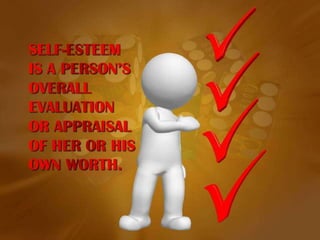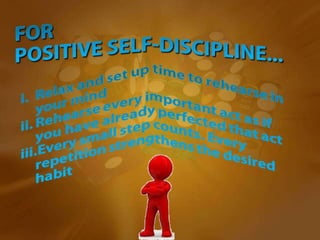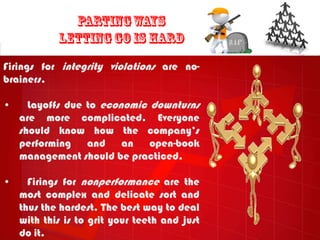Wining
- 2. • What does it take to win? • Winning is achievable. You must, however, learn what makes winning happen. • “Winning” by Jack Welch provides readers with guidelines to follow, rules to consider, assumptions to adopt and mistakes to avoid.
- 3. o A good mission statement and set of values have to be real. o The mission must state exactly where the company is headed (or should be headed). o The values must describe the sort of behavior that gets the company there.
- 4. • An effective mission statement basically answers one question: How do we intend to win in this business? • This questions forces companies to delineate strengths and weaknesses to assess where they can profitably operate in the competitive landscape. • A good mission statement balances the possible and impossible. It gives people the direction to profitability and the feeling that they are part of something big and important. • The mission must be set by top management as it is a defining moment for the leaders of the company.
- 5. • Values must be specific and so descriptive that little is left to the imagination when they are mentioned. • Remember that values are the marching orders that get the company moving. • In contrast to the mission, the values must be determined by everyone in the company. Values are words everyone in the company will have to live by.
- 6. Important Points: • You must reward people for exhibiting company values and punish others who choose not to live by them. • For a company‟s mission and vision to truly work together, they have to be mutually reinforcing. • You will never get anywhere if your mission and values aren‟t as clearly stated and as real as they should be. Spend the time and energy to make this happen.
- 7. • Candor enables everything and everyone to operate faster and better. If people don‟t express themselves frankly, they damage operations and the company greatly. • How does candor lead to winning? - It gets more people to interact. - It generates speed. - It cuts costs by eliminating meaningless meetings • Candor unnerves people. Speaking your mind can lead to a lot of anger and resentment, so it‟s easier not to do so. • Candor is obviously very hard to instill in any group, but again, it‟s something that must exist in any company.
- 8. o Reward and praise publicly those who exhibit candor. o You must remember though that showing candor is a genuine risk. In fact, it might even lead to some people losing their jobs. It will, therefore, be better if candor is instilled from the top. o Candor works because candor unclutters.
- 9. Companies win when managers make distinctions between top- and bottom-performing businesses and people. Managers should cull the weak and cultivate the strong. When every business and person is treated equally, companies suffer. Differentiation is a way to manage people and businesses by allocating resources. Strong businesses or product lines should be invested in more than weak ones. You should use the same principle when dealing with people.
- 10. • Managers need to assess their employees and treat the top 20% like stars. The middle 70% should be motivated and given adequate training and assistance. The bottom 10% should be let go. • It really is not as cruel as it sounds. Often, those who are let go are able to build successful careers in other industries. • In some companies, though, this process can be corrupted by favoritism and cronyism. This sort of system won‟t last and it will collapse under its own weight. • One last thought. If it isn‟t already obvious, differentiation only really annoys the underperformers.
- 11. Every person in this world yearns for voice or the opportunity to speak their minds and have their ideas and opinions heard. Everyone wants dignity or the respect for work and individuality. Although every person deserves voice and dignity, things are different in the workplace. The ideas and opinions of lower-echelon workers often go unheard. You must find a way to get everyone to speak up. Build a culture where everyone respects what everybody has to say.
- 12. There are Eight Rules of Leadership: 1. Leaders relentlessly upgrade their team by evaluating, coaching, and building self-confidence. 2. Leaders make sure people not only see the vision but also live and breathe it. 3. Leaders get into everyone‟s skin, exuding positive energy and optimism. 4. Leaders establish trust with candor, transparency and credit. 5. Leaders have the courage to make unpopular decisions and gut calls. 6. Leaders probe and push with a curiosity that borders on skepticism, making sure questions are answered with action. 7. Leaders inspire risk taking and learning by setting examples. 8. Leaders celebrate.
- 13. Three acid tests you need to conduct before you hire someone: 1. Test for integrity - the capacity to tell the truth, keep one‟s word, take responsibility for one‟s actions, admit mistakes and fix them. 2. Test for intelligence - look for a strong dose of intellectual curiosity. 3. Test for maturity or rather, the ability to withstand stress and setbacks and enjoy success without being arrogant.
- 14. Apply the 4-E 1-P test. Look for: I. Positive energy - the ability to thrive on action. II. The ability to energize others - with a deep knowledge of the business and strong persuasion skills. III. Edge - the courage to make tough yes- or-no decisions. IV. Execute - the ability to get the job done. V. Passion - a deep heartfelt authentic excitement about work.
- 15. Lastly, when hiring senior-level leaders, look for the following characteristics: A. Authenticity - a leader can‟t make tough decisions without knowing who he is and what he stands for. B. The ability to see around corners - a special capacity to anticipate the radically unexpected, which comes with vision. C. The penchant for surrounding themselves with people who‟re better and smarter than they are - to help them make the best decisions. D. Heavy-duty resilience - can he learn from his mistakes and get going again?
- 48. Six Fundamental Practices: 1) Elevate HR to a position of power and primacy in the organization. 2) Use a rigorous, non-bureaucratic evaluation system. 3) Create effective mechanisms (money, recognition, training, etc.) to motivate and retain. 4) Face straight into charged relationships. 5) Don‟t take the middle 70% for granted. 6) Design the org chart to be as flat as possible, with clear reporting relationships and responsibilities.
- 49. Firings for integrity violations are no- brainers. • Layoffs due to economic downturns are more complicated. Everyone should know how the company‟s performing and an open-book management should be practiced. • Firings for nonperformance are the most complex and delicate sort and thus the hardest. The best way to deal with this is to grit your teeth and just do it.
- 50. There are Three Big Mistakes of Firing: 1. Moving too fast - which disrupts equilibrium of the entire office. 2. Not using enough candor - some people are simply unprepared for when they get axed, and can end up causing trouble outside of the company. 3. Taking too long - thus creating enormous awkwardness for everyone. To counteract these, eliminate surprises and minimize humiliation by letting everyone know how they and the company are performing.
- 51. • Change is an absolutely critical part of business. • Companies have to keep changing to stay in the game - let alone win. • Changing successfully comes down to embracing four practices: - Attaching every change initiative to a clear purpose. - Hire and promote only true believers. - Remove resisters, even those who are performing well. - Look at car wrecks.
- 52. • Crises are tough for everyone, but most especially for leaders. During a crisis, leaders are forced to pull off a balancing act. They have to put a large amount of time and energy into dousing the flames and yet must carry on as if nothing is wrong. • Tight controls, good internal processes and a culture of integrity are important in preventing crises from happening at all.
- 53. In case Crisis strikes, the following assumptions should be kept in mind: a) The problem is worse than it appears - the problem is yours to fix so get into a worst-case scenario mindset and start „digging‟. b) There are no secrets in the world - everyone will find out everything, so it‟s best to expose it yourself. c) You and your organization‟s handling of the crisis will be seen in the worst light - the only way to go is to define your position before the media does. d) There will be changes in processes and people - something has to change; sometimes, someone has to pay. e) The organization will survive and be stronger for what happened - but only if it learns from the experience.
- 54. o What is strategy but resource allocation? Strip away all the noise and that‟s what it boils down to. o You need to make clear-cut choices on how to compete. Remember, you can‟t be everything to everybody. o When headed in the right direction, strategies don‟t have to change all that often. o You should think of de-commoditizing. Offer less goods and services. At the same time, offer more distinctive products to make yourself unique and more focused.
- 55. Here are three steps you can use to come up with a strategy: 1. Come up with a big „aha‟ for your business. 2. Put the right people in the right jobs to drive the big „aha‟ forward. 3. Relentlessly seek out the best practices to achieve your big „aha‟, whether inside or out, adapt them and continually improve them.
- 56. • Most companies‟ budgeting processes are awfully ineffective because they bring out some very unproductive behavior - from sandbagging to settling for mediocrity. • The new approach to budgeting is to create an operating plan for the next year that contains numbers that are understood to be targets for the company to achieve. • An operating plan can change as conditions change, whereas conventional budgets can‟t. • This will make the company infinitely more responsive to market changes.
- 57. • Organic growth involves starting new from within an established company. • Here are three guidelines to make organic growth a winning proposition: 1. Spend plenty up front and put the best people in leadership roles. 2. Make an exaggerated commotion about the potential and importance of the new venture. 3. Err on the side of freedom and get off the new venture‟s back.
- 58. • Mergers and acquisitions are other paths - non-organic paths - that companies can take to achieve growth. • Mergers and acquisitions, however, can feel like death. Everything you‟ve worked for can suddenly be null and void. You might even find yourself with a job. • That said, though, companies should still persist in merging. They‟re a faster way to profitable growth. • Merging increases scope, widens product and customer bases and allows companies to improve their workers.
- 59. Seven merger-related pitfalls to avoid: 1. The belief that a merger of equals can occur. 2. Focusing so intently on strategic fit that cultural fit isn‟t assessed. 3. Entering a „reverse hostage situation‟ where the acquirer makes so many concessions that the acquired company calls all the shots afterward. 4. Integrating too timidly. 5. The conqueror syndrome, where the acquirer marches in and replaces even the manager, 6. Paying too much that the premium can never be recouped in the integration. 7. Resistance is futile, and can also be fatal – resisting a deal is usually suicidal for a person‟s career.
- 60. • Six Sigma is a quality program that improves your customers‟ experience, lowers your costs and builds better leaders. This is done by reducing waste and inefficiencies. • Six Sigma is also achieved by designing products and processes so that consumers get what they want, when they want it and when you said you‟d deliver it. • A huge part of making your customers sticky, or faithful to you, is meeting or exceeding their expectations. Six Sigma helps you do this. • In a nutshell, it‟s all about removing variation from your customer‟s interaction with you.
- 62. Here are some important points to consider: In the very best job scenario, choose a job where you love the work, or at least something about it - say the customers, the travel, your officemates or just the challenge of the job. When going after your first job, live in your own skin and be comfortable there. If you are stuck in a position you‟re not happy with, work harder. If you‟ve been let go, don‟t let yourself spiral into inertia and despair. Instead, take responsibility for your departure, be confident and optimistic.
- 63. o Here are some Do‟s and Don‟ts that can help you towards your promotion: o Do‟s: o Deliver sensational performance, beyond expectations, and expand your job beyond its official boundaries every chance you get. o Manage your relationships with your subordinates as carefully as you manage the one with your boss. o Get on the radar screen by becoming an early champion of your company‟s major projects or initiatives. o Search out the input of lots of mentors. o Have a positive attitude and spread it around.
- 64. Don‟ts: • Make your boss use political capital in order to champion you. Let your results speak for themselves; be candid and open; don‟t wear your career goals on your sleeve. • Let setbacks break your stride. Accept them with as much grace as you can and see them as challenges to prove yourself anew.
- 65. Everyone‟s had his or her share of bad bosses. Bad bosses are the sort who grabs the credit, are incompetent, kisses up or kicks down, bullies and humiliates, and so on and so forth. In any bad boss situation, you can‟t let yourself be a victim. It‟s completely self-defeating. Remember that it‟s your problem and you must solve it.
- 66. Ask yourself the following questions: o Why is my boss acting like a jerk? Sometimes the answer‟s a no-brainer (he or she really could be that way). It‟s an entirely different situation if your boss is impossible towards you and you alone. Could you have done something to earn his or her disapproval? You need to find out. o What‟s the endgame for my boss? Is your boss staying or going? If your boss produces good results even though he or she is nasty, your boss might not be going anywhere.
- 67. o What will happen to me if I deliver results and endure? While you‟re waiting for something to happen, give the job your all. Don‟t even think of tattling on your boss. 90% of the time, that sort of thing backfires. o Why do I work here anyway? You might need to assess your tradeoffs and ask yourself, “Are they worth it?” If they aren‟t, just leave gracefully
- 68. o Achieving work-life balance is a process. You get better at it with experience and observation. o A handful of best practices have emerged, and they are: - Keep your head in whatever game you‟re at - Have the mettle to say no to requests and demands outside your work-life balance plan. - Make sure your work-life balance plan doesn‟t leave you out. o Outside of work, find out what you want from life. o At work, find out what your boss wants, and understand that what he or she wants has to come first if you want to get ahead.
- 69. ۞ On the inevitability of China - Reduce costs drastically, get rid of defects (don‟t just reduce them!) and exploit the distance between China and other markets. Innovate! Find new niches to compete in. Lastly, realize that China can also be a market, an outsourcing option, and a potential partner - not just a competitor. ۞ On Jeff Immelt - Jeff is doing exceptionally well as chairman and CEO of GE, having made significant changes to GE‟s portfolio and having put enormous emphasis on diversity, among other things.
- 70. ۞ On the future of the European Union - very good in the long term. An ever-increasing acceptance of capitalism will fuel the steady forward movement of the Union. ۞ Rules like this are a good thing, but laws themselves will never guarantee good corporate governance. People, culture, processes controls and strong directors are what put compliance in a company. ۞ On how to deal with AIDS in West Africa - Winning companies always help the communities they operate in; that’s how good business really works. They build schools, hospitals and in general, give back greatly to the communities that surround them.






































































